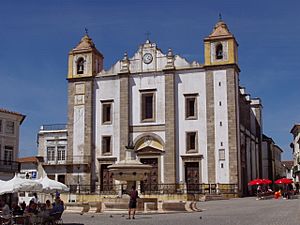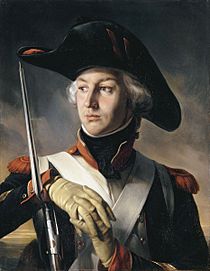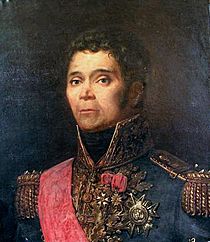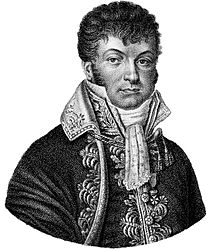Battle of Évora (1808) facts for kids
Quick facts for kids Battle of Évora (1808) |
|||||||
|---|---|---|---|---|---|---|---|
| Part of the Peninsular War | |||||||
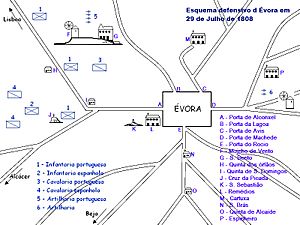 Scheme of the defense of Evora, done by J. C. Baker |
|||||||
|
|||||||
| Belligerents | |||||||
| Commanders and leaders | |||||||
| Strength | |||||||
| 7,000 | 3,000 | ||||||
| Casualties and losses | |||||||
| 300 | 2,000 | ||||||
The Battle of Évora happened on July 29, 1808. It was a fight during the Peninsular War, which was part of the bigger Napoleonic Wars. In this battle, a French army division led by General Louis Henri Loison attacked a combined force of Portuguese and Spanish soldiers. This force was commanded by Francisco de Paula Leite de Sousa.
The battle took place near Évora, a city in Portugal, about 110 kilometers (68 miles) east of Lisbon. The French easily defeated the smaller Portuguese and Spanish army outside the city. Then, they stormed Évora itself. The city was defended by poorly armed citizens and local fighters. The French soldiers killed many of the Portuguese defenders and badly damaged the town.
General Loison was known as the Maneta (meaning "One-Hand") by the Portuguese because he had lost an arm. Because of the cruel actions like those at Évora, people would say ir para o Maneta (going to the One-Hand) to mean something terrible was about to happen.
In November 1807, a French army led by Jean-Andoche Junot had successfully invaded Portugal. They were helped by Spanish troops. The French controlled Portugal for several months. However, in May 1808, the Spanish people rebelled against the French. This uprising was called the Dos de Mayo Uprising. Soon after, the Portuguese also revolted. The French then pulled their troops back from the north and south of Portugal to focus on holding central Portugal. Junot sent Loison east to help the French soldiers at Elvas Fortress. After winning the battle at Évora, Loison reached Elvas. But he was soon called back to help fight a British army. This British army, led by Sir Arthur Wellesley, had landed near Lisbon.
Contents
Why Did the Battle Happen?
In 1807, Emperor Napoleon of France wanted to control all of Europe. He had a plan called the Continental System. This plan aimed to stop countries from trading with his enemy, the United Kingdom. Portugal was a very old friend of Britain and refused to join Napoleon's system.
Napoleon also wanted to stop Britain from trading with Portugal's colony, Brazil. He wanted to take Portugal's ships and use the important port of Lisbon for his own navy. So, he decided to invade Portugal.
In July 1807, France told Portugal to stop trading with Britain. Portugal's ruler, Prince Regent John, tried to agree to some of Napoleon's demands. But it was too late. Napoleon had already sent an army of 25,000 soldiers into Portugal, led by General Junot.
Junot's army marched quickly through Spain and into Portugal. They faced bad weather but no armed resistance. Junot reached Lisbon on November 30, 1807. Before the French arrived, Prince Regent John and about 15,000 people from the government and royal court escaped to Brazil by ship. The British navy helped them.
Even though there was no fighting, many French soldiers died from the harsh march. Some were also attacked by angry Portuguese farmers. Junot took control of Lisbon. He disbanded the Portuguese Army and made people pay high taxes. This made the Portuguese people very angry.
The Portuguese Rebellion Begins
By spring 1808, Junot felt secure in Portugal. He had more troops, and the Portuguese army was gone. Most of Portugal's leaders had fled to Brazil. The country's ports were closed by the British navy, so Portugal couldn't sell its wine or trade with Brazil. Many people in Lisbon became unemployed and poor.
Then, in May 1808, the Spanish people rebelled against the French. This changed everything. When news of the Spanish revolt reached Porto, a city in northern Portugal, the Spanish troops there joined the rebellion. They captured the French general and left Portugal to fight for Spain.
After the Spanish left, the northern parts of Portugal began to revolt. People chose new leaders to fight the French. Junot heard about this and quickly arrested the remaining Spanish soldiers in Lisbon. He put about 6,000 Spanish soldiers on prison ships in Lisbon's harbor.
The rebellion spread south. On June 16, the town of Olhão in southern Portugal rose up. The French governor there was captured and sent away on a British warship. French troops in the south had to retreat.
French Response to the Uprising
Junot had one big advantage: he controlled Lisbon, the main city and military supply center. Only Lisbon could properly equip an army. However, he also had a Russian navy fleet in Lisbon's harbor. The Russian admiral refused to help the French on land, saying his country wasn't at war with Portugal. This meant the French had to feed the Russian sailors, using up their limited food supplies.
Junot tried to follow Napoleon's orders to send troops to Spain. But his generals found that Spanish forces were too strong. They had to turn back. General Loison, for example, tried to march to Porto but faced many local fighters (guerillas). He realized his small force couldn't win and went back to Almeida.
In Lisbon, Junot faced more problems. On June 16, during a religious festival, a panic broke out among the people. Junot rode into the crowd himself to stop his soldiers from firing. He managed to calm everyone down, but Lisbon remained full of rumors. A British army was also waiting off the coast, though Junot didn't know how small it was.
On June 18, a large riot in Porto forced the local leaders to join the rebellion. They formed a new government and started to rebuild the Portuguese army. They found weapons for about 5,000 regular soldiers and many more local fighters.
By late June, Junot and his generals decided to give up the northern and southern parts of Portugal. They would focus on defending central Portugal and the area around Lisbon. They also decided to hold onto important forts like Almeida, Elvas, and Peniche.
Orders were sent to all French forces to move towards Lisbon. Many messengers were captured or killed by Portuguese guerillas. For example, only 1 out of 20 messengers reached Loison. French troops on their way to Lisbon often fought with local people. When Loison marched from Almeida to Abrantes, his path was marked by destroyed villages. This is how he earned his nickname Maneta (One-Hand) and was hated by the Portuguese.
By the second week of July, Junot had about 24,000 soldiers gathered near Lisbon.
The Battle of Évora
In mid-July 1808, there was a quiet period. Then, Junot decided to send General Loison to open a path to Elvas, where French troops were surrounded. Loison's force included about 7,000 soldiers and eight cannons. He left Lisbon on July 25.
The Portuguese leaders in the Alentejo region had their headquarters in Évora. They chose General Francisco de Paula Leite de Sousa to lead their forces. But he had trouble getting enough weapons for his small army.
On July 29, 1808, Loison's troops arrived near Évora. They found a combined Portuguese and Spanish force waiting for them. General Leite had about 1,500 Portuguese infantry and 120 cavalry. Colonel Moretti brought another 1,500 Spanish infantry, some cavalry, and seven cannons from Badajoz. In total, the allied forces had about 2,900 regular soldiers. Behind them, defending the old city walls of Évora, were many citizens and farmers armed with hunting guns and spears.
It would have been smarter for Leite and Moretti to defend from inside Évora's walls. But they chose to fight outside. When Loison's French troops charged, the allied battle line quickly broke. The Spanish cavalry fled, and General Leite also rode away quickly. Most of the infantry tried to regroup behind the city wall.
However, the French soldiers quickly broke into the city in several places. They killed many of the poorly armed defenders. It is likely that many people who were not soldiers were also killed. After defeating the armed resistance, the French brutally looted the city of Évora.
The Portuguese and Spanish forces lost about 2,000 men. The French lost about 90 killed and 200 wounded. On August 1, Loison continued his march to Elvas. He drove away the local fighters who were surrounding the fort there. At Elvas, he received an urgent message from Junot. A British army led by Sir Arthur Wellesley had landed in Portugal on August 1. Loison immediately turned back towards Lisbon. The next major battle was the Battle of Roliça on August 17, 1808.
What Happened Next?
The arrival of the British army led to more important battles, including the Battle of Roliça and the Battle of Vimeiro.
See also
 In Spanish: Batalla de Évora (1808) para niños
In Spanish: Batalla de Évora (1808) para niños
Images for kids


